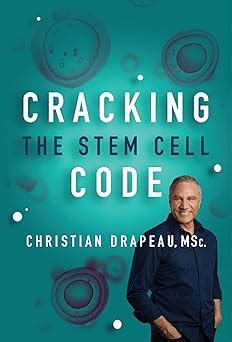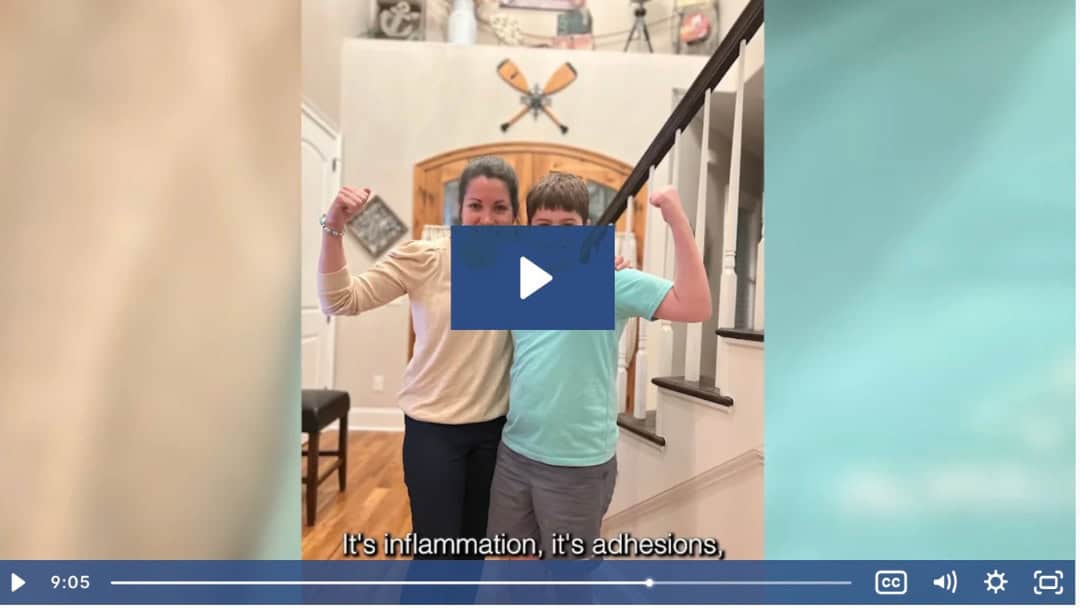What Are Stem Cells?
Stem cells have the unique ability to differentiate into becoming cells of virtually any type of organ or tissue in the body. They are not part of the immune system, but they interact with it in many ways. There are many different kinds and sources of adult stem cells (ASC) within one’s own body, which is what Cracking the Stem Cell Code focuses on.
What Is Stem Cell Therapy?
Stem cell therapy uses the unique properties of stem cells that make up the body’s natural healing and repair system. This therapy is used to regenerate damaged cells and tissues in the human body or replace these cells with new, healthy, and fully functional cells. As Christian Drapeau points out:
“There is probably no scientific field as prolific and as fast moving as the field of stem cell research. Since 2014, every year more than 25,000 scientific studies touching various aspects of stem cell physiology have been published and posted in the NIH Medical Library. Currently, more than 370,000 articles are listed in the field of stem cell research. And yet, in all this work, just a few bits and pieces trickle down to the media, unfortunately painting a picture that does not accurately depict the magnitude of what is currently unfolding in the scientific world.”
How Does Stem Cell Therapy Work?
Although the book describes the history of stem cells as well as the many different kinds of stem cells, bone marrow stem cells (BMSC) are the focus because they constitute the healing system of the body. The mechanism goes like this: After a tissue or organ is injured:
- Specific compounds are released that trigger the release of BMSC
- The number of circulating stem cells increases
- Other compounds are released to attract BMSC to the injured tissue
- BMSC migrate to the injured tissue
- Newly migrated BMSC proliferate
- BMSC then differentiate and turn into the cells of the injured tissue
Supporting the Body to Increase Stem Cells
While much research concentrates on the injection of stem cells to elicit repair, what has become apparent more recently is that it’s the number of stem cells that one has that can be a large factor in healing. In addition, Christian indicates that:
“Supporting the natural release of stem cells from the bone marrow could very well prove to be the easiest, safest and most effective way of tapping into the healing potential of stem cells.”
In other words, instead of having to inject one’s own or another’s stems cells into the body with all of the hassle, cost and potential side effects that might entail, the healing power of stem cells can be brought about supporting the body’s innate design to increase the number of circulating stem cells. Research has shown that simply having more stem cells naturally occurring in the blood stream leads to greater healing. Christian explains that:
“Many of the behaviors and activities traditionally associated with a healthy lifestyle, like a good diet, deep sleep and exercie actually support stem cell function in the body, and likewise, many of the behaviors or activities traditionally associated with an unhealthy lifestyle, like stress, smoking and drinking alcohol have been documented to suppress or reduce stem cell function in the body.”
Once again, the healing basics of adding in therapies and supports while reducing root causes and stressors allows the body to heal in the way in which it was intended.
Stem Cell Enhancers
In addition to providing a comprehensive overview of stem cells and how they heal the body, in the book Christian relates how his career in stem-cell research began when he was hired to study the health properties of a particular blue-green algae noted by locals of Klamath Lake, Oregon for its health benefits. He ultimately discovered that this algae (AFA, Aphanizomenon flos-aquae) transformed people’s health due to its ability to increase the number of circulating stem cells. This discovery led him to seek out other plants that could increase healing from stem cells. Indeed, he found others that increased the number of stem cells, stimulate the mobilization of stem cells from the bone marrow, or stimulate their migration from the blood to tissues:
- Vahona (Aloe macroclada)
- Sea buckthorn berry (Hippophae rhamnoides)
- Notoginseng (Panax notoginseng)
- Colostrum
- Goji berries
- Gotu kola
- Fucoidan from seaweeds
- Reishi mushrooms
- Cordyceps mushrooms
- Hericium mushrooms
In Conclusion
After reading this book, you’ll be left wondering why we haven’t heard more about the research findings of the healing power of stem cells. You’ll also likely share in the author’s enthusiasm and optimism about their vast potential. And you just might double down on doing those healing basics of diet, environment and lifestyle supports, knowing that they could increase your circulating stem cells.
About Christian Drapeau MSc
Christian Drapeau is a stem cell scientist, published researcher and author. He holds a graduate degree in Neurophysiology and has been involved in medical research for 30+ years, the last 20 specifically dedicated to stem cells. He pioneered the understanding that stem cells constitute the body’s natural healing and repair system and has traveled the world in search of the most powerful plants that support stem cell function and enhance the body’s regenerative potential.
He has written 5 books, including the best-selling “Cracking the Stem Cell Code,” as well as dozens of published scientific papers on brain research and the biological process he coined “Endogenous Stem Cell Mobilization”. Having lectured in 50+ countries, he is known by scientists, physicians, and biohackers alike as an expert and pioneer of his field.
A scientific advisor to many companies, he is currently the Founder and Chief Science Officer at STEMREGEN. You can find out more about him and his company at https://www.stemregen.co/

Still Looking for Answers?
Visit the Documenting Hope Practitioner Directory to find a practitioner near you.
Join us inside our online membership community for parents, Healing Together, where you’ll find even more healing resources, expert guidance, and a community to support you every step of your child’s healing journey.
Sources & References
Aggarwal, S., et al. Plant stem cells and their applications: special emphasis on their marketed products. 3 Biotech. 2020 Jun 5;10(7):291.
Akiyama, Y., et al. Remyelination of the rat spinal cord by transplantation of identified bone marrow stromal cells. J Neurosci. 2002 Aug 1;22(15):6623-30.
Amoh, Y., et al. Multipotent hair follicle stem cells promote repair of spinal cord injury and recovery of walking function. Cell Cycle. 2008 Jun 15;7(12):1865-9.
Bickford, P.C., et al. Nutraceuticals synergistically promote proliferation of human stem cells. Stem Cells Dev. 2006 Feb;15(1):118-23.
Borlongan, C.V., et al. Bone marrow grafts restore cerebral blood flow and blood brain barrier in stroke rats. Brain Res. 2004 Jun 4;1010(1-2):108-16.
Chen, J., et al. Intravenous administration of human umbilical cord blood reduces behavioral deficits after stroke in rats. Stroke. 2001 Nov;32(11):2682-8.
Chopp, M., et al. Spinal cord injury in rat: treatment with bone marrow stromal cell transplantation. Neuroreport. 2000 Sep 11;11(13):3001-5.
Contreras, J.L., et al. Peripheral mobilization of recipient bone marrow-derived endothelial progenitor cells enhances pancreatic islet revascularization and engraftment after intraportal transplantation. Surgery. 2003 Aug;134(2):390-8.
Dezawa, M., et al. Potential of bone marrow stromal cells in applications for neuro-degenerative, neuro-traumatic and muscle degenerative diseases. Curr Neuropharmacol. 2005 Oct;3(4):257-66.
Ding, D.C., et al. Mesenchymal stem cells. Cell Transplant. 2011;20(1):5-14.
Drapeau, C., et al. Rapid and selective mobilization of specific stem cell types after consumption of a polyphenol-rich extract from sea buckthorn berries (Hippophae) in healthy human subjects. Clin Interv Aging. 2019 Feb 4:14:253-263.
Emmons, R., et al. Exercise as an Adjuvant Therapy for Hematopoietic Stem Cell Mobilization. Stem Cells Int. 2016:2016:7131359.
Fang, J., et al. Melatonin prevents senescence of canine adipose-derived mesenchymal stem cells through activating NRF2 and inhibiting ER stress. Aging (Albany NY). 2018 Oct 25;10(10):2954-2972.
Hasegawa, Y., et al. Bone marrow (BM) transplantation promotes beta-cell regeneration after acute injury through BM cell mobilization. Endocrinology. 2007 May;148(5):2006-15.
He, F., et al. Ginsenoside Rg1 as a Potential Regulator of Hematopoietic Stem/Progenitor Cells. Stem Cells Int. 2021 Dec 31:2021:4633270.
Jensen, G.C., et al. The use of in situ bone marrow stem cells for the treatment of various degenerative diseases. Med Hypotheses. 2002 Oct;59(4):422-8.
Kaneko, Y., et al. Bone marrow-derived stem cell therapy for metastatic brain cancers. Cell Transplant. 2015;24(4):625-30.
Li, C., et al. The potential of plant extracts in cell therapy. Stem Cell Res Ther. 2022 Sep 14;13(1):472.
Li, Y., et al. Human marrow stromal cell therapy for stroke in rat: neurotrophins and functional recovery. Neurology. 2002 Aug 27;59(4):514-23.
Liu, Q., et al. Rational use of mesenchymal stem cells in the treatment of autism spectrum disorders. World J Stem Cells. 2019 Feb 26;11(2):55-72.
Marchesi, C., et al. Skin-derived stem cells transplanted into resorbable guides provide functional nerve regeneration after sciatic nerve resection. Glia. 2007 Mar;55(4):425-38.
Mezey, E., et al. Transplanted bone marrow generates new neurons in human brains. Proc Natl Acad Sci U S A. 2003 Feb 4;100(3):1364-9.
Mias, C., et al. Ex vivo pretreatment with melatonin improves survival, proangiogenic/mitogenic activity, and efficiency of mesenchymal stem cells injected into ischemic kidney. Stem Cells. 2008 Jul;26(7):1749-57.
Musiał-Wysocka, A., et al. The Pros and Cons of Mesenchymal Stem Cell-Based Therapies. Cell Transplant. 2019 Jul;28(7):801-812.
Nishino, H., et al. Restoration of function by neural transplantation in the ischemic brain. Prog Brain Res. 2000:127:461-76.
Painovich, J., et al. A Randomized, Controlled Pilot Study of the Effects of Acupuncture on Circulating Endothelial Progenitor Cells in Coronary Heart Disease. Integr Med (Encinitas). 2014 Apr;13(2):27-33.
Qian, X.D., et al. [Proliferation and differentiation of human CD34+ hematopoietic stem/progenitor cells induced by Panax notoginosides]. Zhongguo Shi Yan Xue Ye Xue Za Zhi. 2003 Apr;11(2):120-3.
Qu, J., et al. Efficacy and Safety of Stem Cell Therapy in Children With Autism Spectrum Disorders: A Systematic Review and Meta-Analysis. Front Pediatr. 2022 May 4:10:897398.
Peterson, D.A. Stem cells in brain plasticity and repair. Curr Opin Pharmacol. 2002 Feb;2(1):34-42.
Siniscalco, D., et al. Mesenchymal stem cells in treating autism: Novel insights. World J Stem Cells. 2014 Apr 26;6(2):173-8.
Tamouza, R., et al. Possible Effect of the use of Mesenchymal Stromal Cells in the Treatment of Autism Spectrum Disorders: A Review. Front Cell Dev Biol. 2022 Jul 5:10:809686.
Voltarelli, J.C., et al. Autologous nonmyeloablative hematopoietic stem cell transplantation in newly diagnosed type 1 diabetes mellitus. JAMA. 2007 Apr 11;297(14):1568-76.
Wu, S., et al. Neural stem cells improve learning and memory in rats with Alzheimer's disease. Pathobiology. 2008;75(3):186-94.
Zhang, J., et al. [Study on Panax notoginseng mobilizing marrow stem cells efferens efficiency of acute myocardial infarction in rats]. Zhongguo Zhong Yao Za Zhi. 2009 Apr;34(7):893-5.
Zheng, H., et al. Total saponins of Panax notoginseng enhance VEGF and relative receptors signals and promote angiogenesis derived from rat bone marrow mesenchymal stem cells. J Ethnopharmacol. 2013 Jun 3;147(3):595-602.
Resources
Articles
Everything parents should know about stem cell therapy for Autism. Parent’s Guide to Cord Blood Foundation, May 2019.
Fetyukhina, Aleksandra. Mesenchymal Stem Cell Infusions for Children with ASD: Swiss Medica Research Study Results. SwissMedica, 26 Jun 2024.
Stem cell therapy. RaisingChildren.net.au. Accessed 14 Apr 2025.
Stem Cell Therapy for Autism. Beike Biotechnology. Accessed 14 Apr 2025.
The Story of Christian Drapeau and the Birth of STEMREGEN. STEMREGEN. Accessed 14 Apr 2025.





